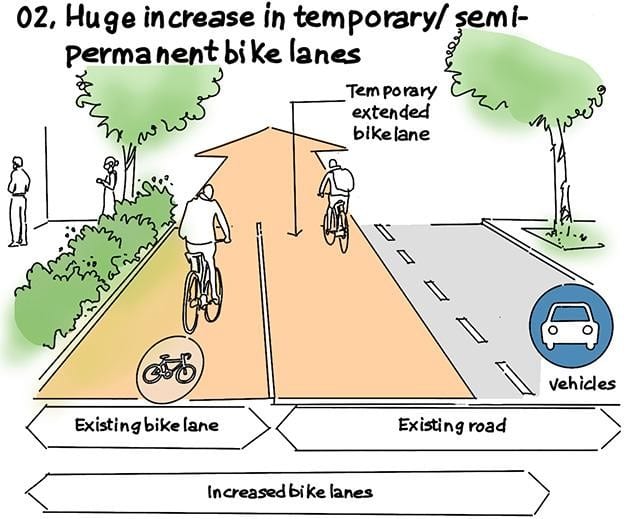Architecture and urban design studio Weston Williamson has illustrated its design concepts for retaining social distancing measures when Londoners return to work.
After Boris Johnson announced that workers in the construction industry, alongside other workers who could not work from home, should be encouraged to return to their roles, many were then shocked to see public transport in London crammed with commuters when lockdown restrictions eased. Of course, Boris had been clear that workers should avoid public transport where necessary, and use a car, bicycle or walk to work; however, according to Transport for London, the city average 0.3 cars per adult, with 46% of households not owning a car. Couple this with the fact that lower income households were more likely to work in construction or not be able to work from home are much less likely to own a car in London, and you can see the problem with the Prime Minister’s solution for Londoners.
Tackling the problem, in the short term and when lockdown restrictions ease further, may be crucial in avoiding a second wave of COVID-19 cases. Urban design and architecture firm Weston Williamson has created a 12-step concept for London’s commuter strategy during the pandemic, which, if adopted, could even see the city’s road infrastructure change for good.
The concept is based on the design practice’s own plans for returning to work, in that staggered shifts working from home means that only a third or half of staff will be in an office at any one time.

To encourage cycling and dissuade workers from using public transport, Weston Williamson has suggested resizing bike lanes, as well as offering free cycle hire. It also envisages new pop-up cycle service points where bicycle repairs can be easily made, as well as free water points for cyclists and pedestrian commuters.
The use of electric scooters on the road would be permitted, and coaches would be drafted in to help reduce capacity on individual London buses. Throughout public transport, commuters would have to book a time to travel, in 15 minute slots, to control the flow of people and avoid overcrowding at any one time. Some Tube stations would also be converted to discharge only stops and every other chair on an underground carriage would be taped up to ensure social distancing. Placing cleaning systems at the top and bottom of escalators would also help to ease concerns about touching these, while ensuring safe use.
No cars would be permitted in the Congestion Charge zone before 10.30am, after which only cars with 3 or more passengers would be permitted.

This concept also takes aims at some of the classic gripes with London’s road design and planning in particular. Suggestions to use this moment in time to ‘green the city’ and improve cyclist infrastructure frame the slowdown caused by social distancing during the pandemic as a clean break – an opportunity to address London’s commuting issues while there’s a chance, as widespread disruption is already in effect.


















